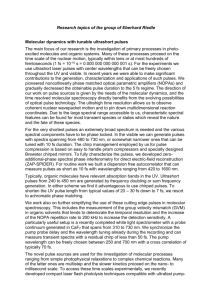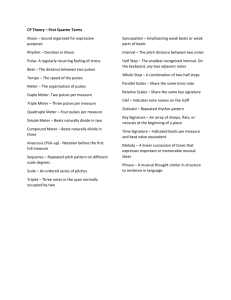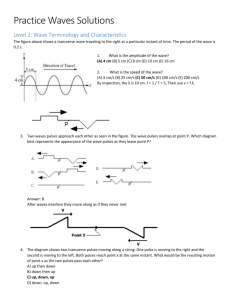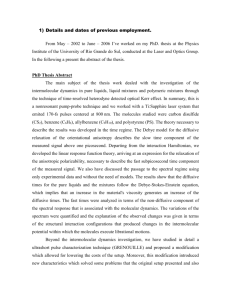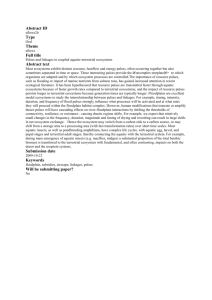India's Pulses Scenario - National Food Security Mission
advertisement
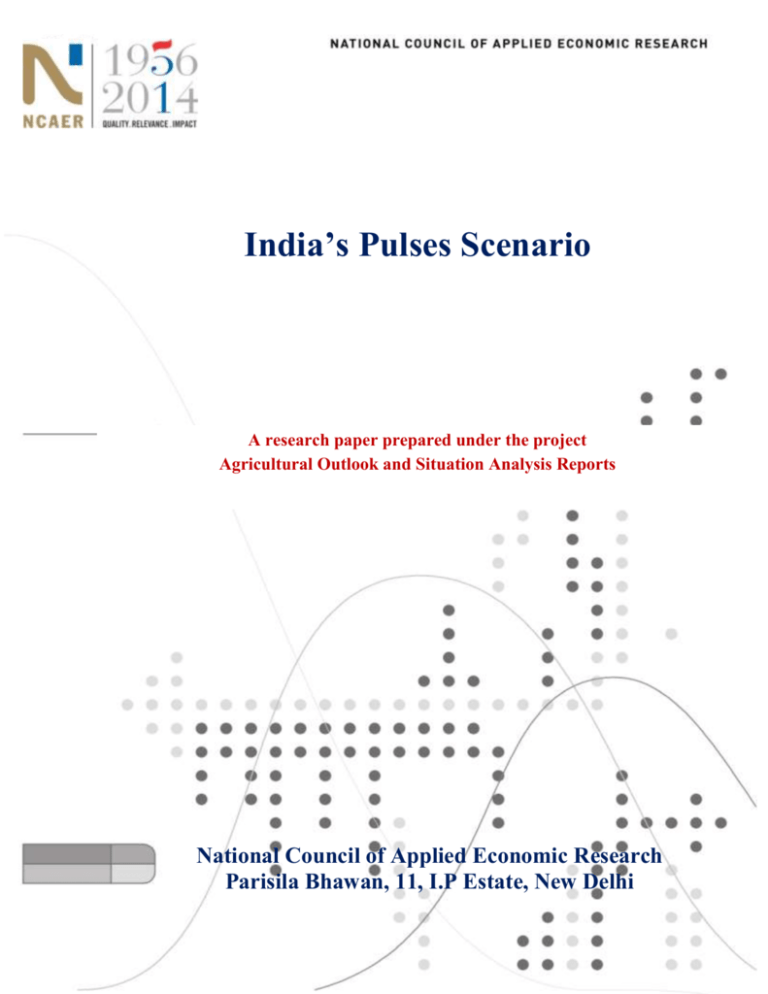
India’s Pulses Scenario A research paper prepared under the project Agricultural Outlook and Situation Analysis Reports National Council of Applied Economic Research Parisila Bhawan, 11, I.P Estate, New Delhi i ii India’s Pulses Scenario National Council of Applied Economic Research New Delhi iii iv India’s Pulses Scenario Introduction This paper analyzes India’s pulse production, consumption, price and trade trends. India is the largest producer, largest consumer and the largest importer of pulses in the world. In India Pulses are grown in around 24-26 million hectares of area producing 17-19 million tonnes of pulses annually. India accounts for over one third of the total world area and over 20 per cent of total world production. India primarily produces Bengal gram (chickpeas), red gram (tur), lentil (masur), green gram (mung) and black gram (urad). For majority of vegetarian population in India, pulses are the major source of protein. Pulses and pulse crop residues are also major sources of high quality livestock feed in India. Production Trend In India pulses are cultivated on marginal lands under rain fed conditions. Only 15% of the area under pulses has assured irrigation. Because of the high level of fluctuations in pulse production (due to biotic and abiotic stress) and prices (in the absence of an effective government price support mechanism) farmers are not very keen on taking up pulse cultivation despite high wholesale pulse prices in recent years. Farmers are getting attracted towards cash crops like Bt cotton, maize and oilseeds (mainly soybeans) because of better return and lower risk. Consequently area under these crops has increased over the years to the detriment of pulses (Table 1). Table1: Area Production and Yield of Total Pulses in India Year Area (million hectares) Production(million tonnes) Yield (kg./ hectares) 1980-81 22.46 10.63 473 1990-91 24.66 14.26 578 2000-2001 20.35 11.08 544 2010-11 26.40 18.24 691 2011-12 24.46 17.09 699 2012-13 23.47 18.34 781 Nevertheless, improvement in yields, albeit modest, has contributed to higher pulse production in recent years (Figure 1). Most of the increase in pulse production in recent years has been in gram (Figure 2). Low pulse yield in India compared to other counties is attributed to poor spread of improved varieties and technologies, abrupt climatic changes, vulnerability to pests and diseases, and generally declining growth rate of total factor productivity . 1 Figure 1: Trend in Area, Yield, and Production of Pulses 2000 1800 25 1600 1200 1000 15 800 10 600 400 5 200 0 Area Production Yield Linear (Area) Linear (Production) Figure 2: Trend in Pulse Production by Type 25 Million Tonnes 20 15 10 5 0 Gram Tur Mung 2 Urad Other 2013-14 F 2012-13 2011-12 2010-11 2009-10 2008-09 2007-08 2006-07 2005-06 2004-05 2003-04 2002-03 0 Linear (Yield) Kgs/Hectare 1400 20 2001-02 Area(Million Hectares)/Production (Million Tonnes) 30 In order to give the much needed fillip to pulse production, the government has included pulses in the NFSM (along with wheat and rice) since the launch of NFSM in October 2007 and has been significantly increasing the MSP for most pulses. Over the past four years, the increase in MSP was a massive 87 percent for tur, 71 percent for urd, and 63 percent for mung. Among rabi pulses MSP for gram for MY 2014-15 was fixed at Rs. 3,100 per quintal and masur at Rs, 2,950 per quintal, although a modest increase over the MY 2013-14 level of Rs. 3,000 and Rs. 2,900 per quintal, nevertheless a massive increase of 76 percent and 58 percent, respectively, since 2010-11 (Figure 3). Rupees per Qunital Figure 3: Trend in Minimum Support Prices for Pulses 5000 4500 4000 3500 3000 2500 2000 1500 1000 500 0 2007-08 2008-09 2009-10 2010-11 2011-12 2012-13 2013-14 2014-15 Tur 1550 2000 2300 3000 3200 3850 4300 Mung 1700 2520 2760 3170 3500 4400 4500 Urad 1700 2520 2520 2900 3300 4300 4300 Gram 1445 1600 1730 1760 2100 2800 3000 3100 Masur 1545 1700 1870 1870 2250 2800 2900 2950 Consumption and prices Pulse production has recorded less than one percent annual growth during the past 40 years, which is less than half of the growth rate in Indian human population. Consequently per capita production and availability of pulses in the country has witnessed sharp decline. Per capita net pulse availability has declined from around 60 grams per day in the 1950s to 40 grams in the 1980s and further to around 35 grams per day in 2000s. However, in the past four years, there has been significant increase in consumption averaging around 50 grams due to somewhat higher production, thanks to the National Food Security Mission (NFSM) focus on pulses, and larger imports, mostly of dry peas from Canada and Australia (Figure 4). 3 Figure 4: Per capita net availability of pulses 80 70 Grams/day 60 50 40 30 20 10 0 1951 1961 1971 1981 1991 2001 2005 2006 2007 2008 2009 2010 2011 2012 Higher production combined with larger imports has resulted in a marginal increase in pulse consumption estimated at around 50 grams per day in 2012-13 compared to less than 40 grams prior to 2012-13. This level of consumption is estimated to have been maintained in 2013-14. Lager imports of dry peas in recent years due its lower international prices have resulted in its increased share in the domestic pulse consumption. The increasing mismatch between production and consumption of pulses has resulted in larger imports of pulses in recent years. Imports of pulses in 2012-13 (Apr-Mar) were a record 4.0 million tonnes an increase of 500,000 tonnes over 2011-12. 2012-13 imports included 1.37 million tonnes of dry peas and dun peas (mattar), 506,000 tonnes of pigeon pea (tur), 642,000 tonnes of green pea (mung), 698,000 tonnes of chick peas, 506,000 tonnes of lentil (masur), 84,000 tonnes of kidney beans (rajma), 180,000 tonnes of other beans and 24,000 tonnes of other pulses. Imports in 2013-14 through November 2013 at 2 million tonnes were about 500,000 tonnes behind imports during the corresponding period of 2012-13 reflecting larger domestic production and higher cost of imported pulses due to the depreciation of Indian rupee against US$. Total imports in 2013-14 are projected at 3.5 million tonnes. Domestic price inflation for pulses as a group measured by Wholesale Price Index remained in the negative territory since June 2013, largely due a significant decline in gram prices, the major pulse in India. Price inflation in other pulses, mainly mung and masur, although showing some declining trend, remained high in 2013 (see Figure 5). Due to expected higher production of gram in 2014, price inflation of pulses as a group is likely to remain subdued in 2014-15, unless the 2014 kharif season pulse crop declines significantly. 4 Figure 5: Wholesale Price Inflation Trend in Pulses (% change in 2013 over 2012) % Change 2013 over 2012 30.0 20.0 10.0 0.0 -10.0 -20.0 -30.0 All Pulses Gram Arhar Mung Masur Urad Jan 15.9 22.5 7.9 19.6 18.1 -0.4 Feb 14.0 16.4 11.4 17.8 19.1 3.2 Mar 10.8 7.6 17.1 17.1 20.2 5.5 Apr 10.5 4.5 20.6 19.1 23.0 6.8 May 5.9 -2.2 16.6 18.5 15.8 7.0 Jun 1.6 -9.2 14.2 20.1 15.6 4.6 Jul -7.4 -19.8 5.1 12.1 11.7 0.8 Aug -14.7 -27.2 -2.6 3.4 6.4 -5.4 Sep -13.4 -25.5 -2.8 8.8 6.1 -7.1 Oct -10.7 -23.9 0.6 14.3 6.0 -2.7 Nov -10.6 -26.2 3.9 14.5 6.9 3.9 Dec -7.2 -23.5 9.2 16.9 12.5 5.2 Trade India imported about 4 million tonnes of pulses during 2012-13. Although based on current assessment kharif pulses production in 2013-14 has remained nearly the same as in 2012-13, due to a likely increase in rabi season pulse production, imports are expected to decline marginally during 2014-15. . From Figure 6 it is seen that import of pulses in 2013 has shown a decline in September. Gram imports were the highest in January, but became negligible thereafter as domestic production was at a record level. Dry pea imports are seen to be fluctuating while masur imports increased till July 2013. Overall, import requirements may be of the order of 3.8 million tonnes in the current year. 5 Figure 6: Month wise Pulse Import during 2013 2.5 Lakh tonnes 2 1.5 1 0.5 0 Jan Feb Mar Chana Pea Apr May Jun Urd & Moong Jul Tur Aug Sep Masoor Despite being world’s largest producer of pulses, only small exports of pulses are taking place from India, both because of restrictions on exports and the high domestic demand. The supplydemand balance sheet for pulses is provided in Table 2. Table 2: Demand and Supply Balance Sheet for Pulses (000 tonnes) Total pulses 2010-11 2011-12 2012-13 Production 18,240 17,090 18,340 Imports 2,780 3,500 4,010 Total supply 21,020 20,590 22,350 Total Export 209 175 200 Domestic Use 20,811 20,415 22,150 Total utilization 21,020 20,590 22,350 % imports to 15.2 20.5 21.7 production 2013-14 19,770 3,500 23,270 200 23,070 23,270 17.8 Summary and Conclusion Because of the high level of fluctuations in pulse production (due to biotic and abiotic stress) and prices (in the absence of an effective government price support mechanism) farmers are not very keen on taking up pulse cultivation despite high wholesale pulse prices in recent years. Nevertheless, improvement in yields, albeit modest, has contributed to higher pulse production in 6 recent years, with most of the increase in pulse production in recent years in gram. Low pulse yield in India compared to other counties is attributed to poor spread of improved varieties and technologies, abrupt climatic changes, vulnerability to pests and diseases, and generally declining growth rate of total factor productivity. In order to give the much needed fillip to pulse production, the government has included pulses in the NFSM (along with wheat and rice) since the launch of NFSM in October 2007 and has been significantly increasing the MSP for most pulses. This has resulted in an above normal growth in pulse production in recent years. In the past four years, there has been significant increase in pulse consumption averaging around 50 grams due to somewhat higher production and larger imports, mostly of dry peas from Canada and Australia. The increasing mismatch between production and consumption of pulses has resulted in larger imports of pulses in recent year with imports in 2012-13 (Apr-Mar) reaching a record 4.0 million tonnes an increase of 500,000 tonnes over 2011-12. Despite being world’s largest producer of pulses, only small exports of pulses are taking place from India, both because of restrictions on exports and the high domestic demand. 7 References 1. Agricultural Statistics at a Glance, 2013, Directorate of Economics and Statistics, Ministry of Agriculture. Directorate of Economics and Statistics http://eands.dacnet.nic.in 2. Department of Agriculture and Cooperation - www.agricoop.nic.in 3. Agriwatch - Commodity Prices India, Commodity Markets – www.agriwatch.com 4. India Pulses & Grains Association, Mumbai – www.ipga.co.in 5. Commission for Agriculture Costs and Prices - http://cacp.dacnet.nic.in/ 6. Office of the Economic Adviser - www.eaindustry.nic.in 7. Central Statistical Organisation - http://mospi.nic.in 8. Directorate General of Commercial Intelligence and Statistics – www.dgciskol.nic.in 8

